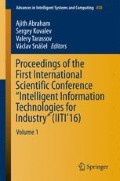Abstract
The paper discusses a general scheme of constructing different systems of artificial intelligence and data mining. This scheme interprets various intelligent technologies as kinds of reasoning. All of these kinds of reasoning aim to cognition and formation of domain models. We assume that reasoning has a referential character, i.e. reasoning can use semantic arguments as well as syntactic rules of deduction. We use some non-classical logics to formalize cognitive reasoning.
Access this chapter
Tax calculation will be finalised at checkout
Purchases are for personal use only
References
Anshakov, O., Gergely, T.: Cognitive Reasonimg: A Formal Approach. Springer (2010)
Rosser, J.B., Turquette, A.R.: Many-valued logics. Br. J. Philos. Sci. 5(17), 80–83 (1954)
Anshakov, O.M., Finn, V.K., Skvortsov, D.P.: On axiomatization of many-valued logics associated with formalization of plausible reasonings. Stud. Logica. 48(4), 423–447 (1989)
Anshakov, O., Rychkov, S.: On finite-valued propositional logical calculi. Notre Dame J. Formal Logic 36(4), 606–629 (1995)
Mill, J.S.: A System of Logic. University Press of the Pacific, Honolulu (2002)
Finn, V.K.: Plausible inferences and plausible reasoning.Itogi Nauki i Tekhniki. Ser. Teor. Veroyatn. Mat. Stat. Teor. Kibern. 28, 3–84 (1988). [English version in: Journal of Soviet Mathematics, 56:1 (1991), 2201–2248.]
Finn, V.K.: Timely notes about the JSM method for automatic hypothesis generation. Autom. Documentation Math. Linguist. 43, 5, 257–269 (2009)
Anshakov, O.M.: The JSM method: a set-theoretical explanation. Autom. Documentation Math. Linguist. 46(5), 202–220 (2012)
Lyfenko, N.D.: An approach to text data categorization based on the ideas of J.S. Mill. Autom. Documentation Math. Linguist. 49(6), 202–212 (2015)
Hajek, P., Havranek, T.: Mechanizing Hypothesis Formation. Springer (1978)
Author information
Authors and Affiliations
Corresponding author
Editor information
Editors and Affiliations
Rights and permissions
Copyright information
© 2016 Springer International Publishing Switzerland
About this paper
Cite this paper
Anshakov, O., Gergely, T. (2016). Cognitive Reasoning Framework: Possibilities, Problems, Prospects. In: Abraham, A., Kovalev, S., Tarassov, V., Snášel, V. (eds) Proceedings of the First International Scientific Conference “Intelligent Information Technologies for Industry” (IITI’16). Advances in Intelligent Systems and Computing, vol 450. Springer, Cham. https://doi.org/10.1007/978-3-319-33609-1_1
Download citation
DOI: https://doi.org/10.1007/978-3-319-33609-1_1
Published:
Publisher Name: Springer, Cham
Print ISBN: 978-3-319-33608-4
Online ISBN: 978-3-319-33609-1
eBook Packages: EngineeringEngineering (R0)

